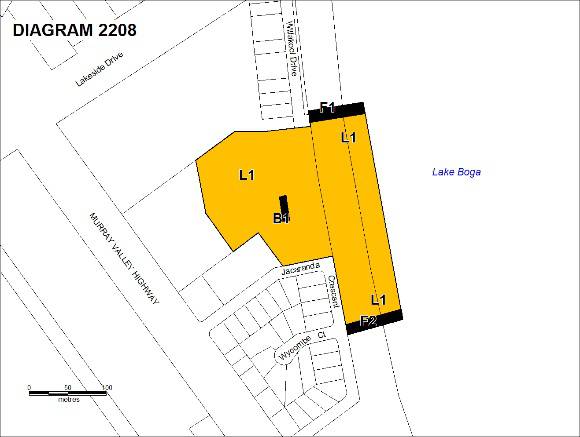| Back to search results » | Back to search page » |
|
LAKE BOGA FLYING BOAT MUSEUM
Other NameFormer RAAF Flying Boat Repair Depot LocationWILLAKOOL DRIVE LAKE BOGA, SWAN HILL RURAL CITY
File NumberPL-HE/03/1324LevelRegistered |
|
Statement of Significance
What is significant?
The Lake Boga Flying Boat Museum is located on a foreshore site which
was part of the World War II RAAF Flying Boat Repair Depot. It
features an original communications bunker, slipways, a Catalina
flying boat of the type which was serviced and repaired there during
the War, and a collection of related artefacts. Flying boats were an important component of the RAAF war effort. The
Catalina aircraft, which was first produced in the US in 1939, was
quickly adopted by many of the allied forces, and formed the backbone
of the RAAF flying boat fleet. Although it had a low top speed for a
fighting aircraft, it also had outstanding load carrying capacity and
endurance and was extremely robust. It was deployed extensively in the
western Pacific for bombing, reconnaissance, supply drops and rescue
missions. The RAAF placed its first order for 18 PBY-5 Catalina flying
boats in 1940. The first RAAF flying boat operations started in
January 1942 with a raid by Catalinas from a base in Port Moresby.
From April 1943 specialized RAAF Catalina squadrons, known as 'Black
Cats', flew long distance night-time mine-laying missions which
effectively disrupted Japanese shipping). The USAF deployed similar
squadrons, also known as the 'Black Cats'. Following Japanese air attacks on northern Australian towns in early
1942, northern bases and the main flying boat base at Rathmines on
Lake Macquarie in NSW were considered vulnerable, and the Department
of Air decided to build an inland RAAF flying boat repair depot.
Qantas Empire Airways had already established an emergency base at
Lake Bogain anticipation of a possible threat to its Rose Bay Sydney
base. This site had a number of advantages - the lake was clear of
obstructions, with flat surrounds, and aircraft could take off from
the lake in any direction. The site was serviced by a railway, and
power was available from Swan Hill, which also had an aerodrome. The first personnel arrived in late June 1942. Open fronted
'grandstand' hangars, workshops and stores buildings were established
on concrete aprons around a curve on the foreshore, serviced by two
concrete slipways, with a central timber fuelling jetty. Moorings
buoys were set up in a long arc around the lake. The concrete
semi-underground radio communications building was located in a
central open area in front of the hangars. A similar bunker for VHS
radio transmission was located on higher ground to the southwest of
the town. At first personnel were accommodated at Swan Hill, but an
RAAF barracks and WAAAF quarters were established at the western end
of the Lake Boga township by the end of 1942. The first RAAF Catalina arrived at the Lake in July, and the first
repaired Catalina took off in September. The base also serviced flying
boats from the Royal Netherlands East Indies Air Force and US forces.
In all, 416 aircraft were serviced and repaired at the base, including
Catalinas, Dorniers, Kingfishers, Short Sunderlands, Supermarine
Walruses and Martin Mariners. Catalinas were the only aircraft to see
service with the RAAF for the entire wartime operations, and 168 were
acquired by the RAAF. After the Japanese surrender, Catalinas were
used to ferry home ex-prisoners of war, as well as servicemen from
Borneo, New Guinea and the islands. The Lake Boga base was closed in
1947, when the majority of buildings were removed. The concrete radio communications bunker and two slipways remain on
the foreshore site, along with a reconstructed PBY Catalina. Elsewhere
on the former base there are remains of the concrete aprons and
footings from the hangars and maintenance sheds, a concrete emergency
generator house and remnants of posts and earthworks from the original
perimeter fence. The VHF radio communications bunker and scattered
evidence of the former barracks area remain to the west of the town. A
playing field now occupies the site of the parade ground.
How is it significant?
The Lake Boga Flying Boat Museum site is of historical and social
significance to the State of Victoria
Why is it significant?
The Lake Boga Flying Boat Museum site is of historical significance
for its rarity as part of the only dedicated flying boat repair base
which operated in Australia during World War II, and as part of the
only inland flying boat base operating in Australia during that conflict. The Lake Boga Flying Boat Museum site is of historical significance
as a component in the flying boat operations of the RAAF, which made
an important contribution during the Allied conflict with Japan. The Catalina aircraft on the Lake Boga Flying Boat Museum site is of
historical significance for its rarity as one of only a few remaining
examples of this important wartime aircraft in Australia. The Lake Boga Flying Boat Museum site is of historical significance
for its capacity to demonstrate the features of an RAAF base
established under the difficulties and contingencies of wartime, in
contrast to the more formal and self-contained bases established
before World War II. The Lake Boga Flying Boat Museum site is of historical significance
for its connection with important missions and battles during World
War II. Aircraft which participated in those events were serviced at
the base. The Lake Boga Flying Boat Museum site and collection is of social
significance for its associations for RAAF and WAAAF personnel and
their families, and for the local community which was involved in the
establishment and activities of the base.
Group
Military
Category
Defence Base Airforce








